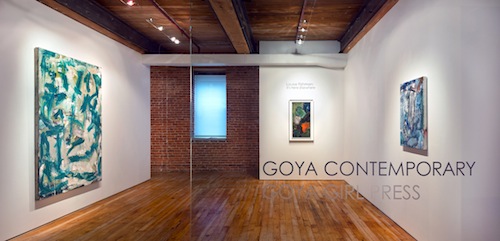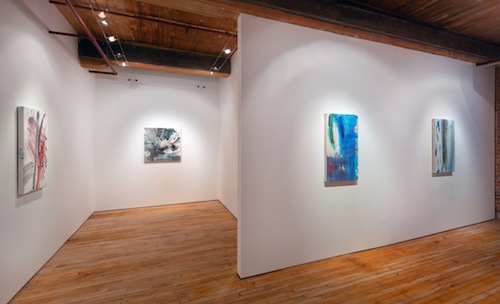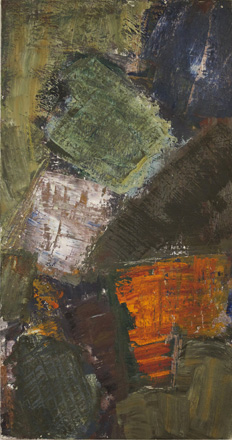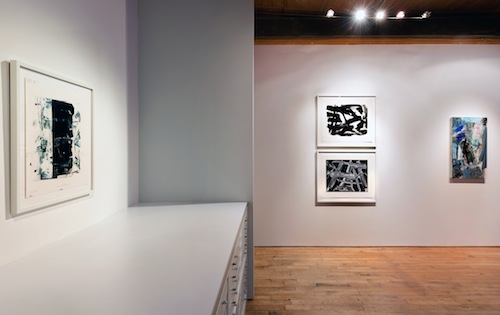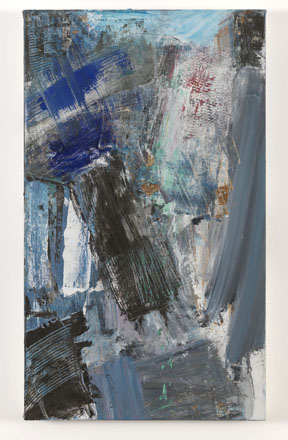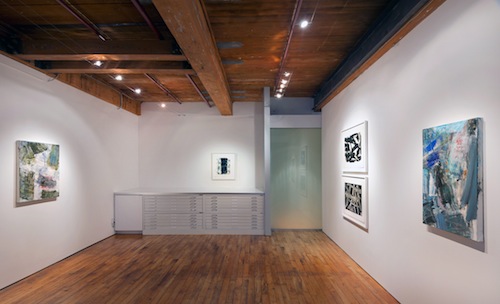This current exhibition is in some respects a continuation of significant fall showings of Fishman’s work at Cheim and Read, the venerable New York gallery; and a 50-year retrospective at Tilton Gallery on New York’s upper East Side. If the earlier shows were characterized in part by large canvases including Fishman’s signature, physical style, the Baltimore show, curated by Amy Raehse at Goya Contemporary, is a harmonious installation of gestural canvases on a more modest scale paired with monoprints and aquatints.
Fishman was born in 1939 in Philadelphia to an artistic family; her mother studied at the Barnes Foundation and her aunt worked for David Alfaro Siquerios, the Mexican muralist. As a result, Fishman was well aware from an early age of modern and contemporary trends in the visual arts. Not surprisingly, Fishman has explored a variety of approaches to make her point: feminist forms and ideas, exploration of the grid, and the utilization of fiber and sewing. Many familiar with her later work have commented that her recent canvases and prints, including many of those at Goya, reflect her current circumstances: a new marriage to Ingrid Nyeboe, a graphic designer; a residency in Venice; and a trip to Steamboat Springs, Colorado, in the Rocky Mountains.
It’s Here – Elsewhere includes 16 works, 14 of which are dated from 2011 to the current year. The earlier pieces, Headwaters (1987) and October (1998) set the stage. The former serves as the de facto ambassador with its ‘title wall’ presence and simple, yet bold, double frame. It’s reminiscent of celebrated Ab-Ex masterpieces, such as a venerated Hans Hofmann at the Milwaukee Art Museum from 1957 entitled Dew and Dusk. Even with 30 years separating them, the works share strong gestural marks; a harmonious relationship among colors; compositional tension; and the visible, inherent qualities of paint as it transitions from liquid to solid. At a glance, Fishman’s October (1998) appears less ambitious with its dominant, rhythmic arrangement of greenish, teal gestures. But this assessment would not account for the rich background. This bubbling undercurrent reveals tan, lavender, earthy browns, and other colors that originate with nature. While this would suggest a harmonious relationship among pigments, Fishman has left evidence of dripping, erasure, pentimenti and other tactile interventions. The evidence of impasto, small accretions of relatively undisturbed paint, hints at survival amid relative chaos.
With Headwaters and October, viewers are given the template to search out consistent elements in the later work. The Day In Its Color, 2013, may be a response to the artist’s recent trip to Venice, an experience that elevated the inclusion of blue pigment in her work. This phenomenon may relate to the watery nature of the city or to her admiration for the works of Titian and, specifically, his utilization of blue with Vermilion and white. Incidentally, neither Fishman nor Titian felt the need to hide their works’ structural support whether it were canvas or linen.
Precarious Music, also from 2013, has a fitting title for an explosive piece, fleeting in its existence with comparisons to crashing sounds. Song to Fall Like Water on My Head (2012) is a shift away from the tactile toward a forceful flattening of the pigment. With the exception of small accretions such as the one on the upper left, Fishman has kept her viewer guessing as to what physical interventions one might find. Delicate Cluster employed a screen pattern that suggests the mystery of a tire track, footprint, or general impermanence.
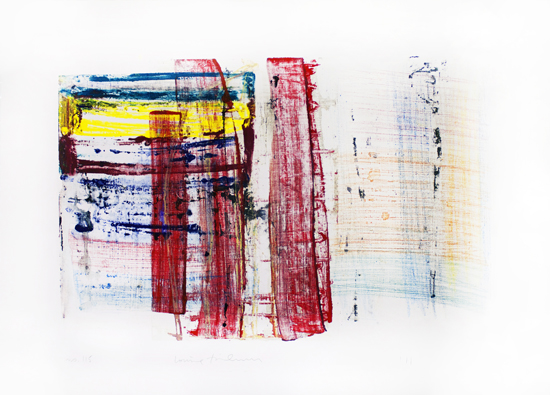 Homage to the Mountains, No. 115
Homage to the Mountains, No. 115
The Homage to Mountains print series was created during Fishman’s recent trip to Steamboat Springs, in the Colorado Rockies, where she worked with Oehme Graphics. Incidentally, Oehme graphics was formed in 2010 with the mission of working with nationally recognized artists to collaborate, provide residencies, host educational workshops and so on. Their specialty appears to be intaglio prints and monotypes. Predictably, prints by nature are less tactile than their painted counterparts, excepting for the plates’ indentations. In Fishman’s asymmetrical arrangement in Homage to the Mountains No. 115 (2011), the plates have created a subtle framing device where one imagines the bold, red marks forming central mountains (or indigenous Aspen trees) with the peripheral colors serving as complementary elements.
This last exercise that invites viewers to read abstract work as autobiographical can be dangerous, even in this exhibition. It can lead to a dark, perhaps skewed reading of a work such as Toute Suite #8 with its bold slashes and precarious structure. Should this work along with Homage to the Mountains 101, with its black pigment bleeding past the plate mark, be read in narrative terms? Does it hint at a foreboding, earlier narrative in the artist’s life? Perhaps. Or it may have been the artist reducing the variables in this particular print exercise.
With paintings across the decades, plus aquatints, monoprints, and a new set of inspiring circumstances, Louise Fishman: It’s Here – Elsewhere has many exciting turns that invite comparisons to the artist’s life events while giving a nod to her past approaches to making art. This referential quality does not make It’s Here – Elsewhere a retrospective. But it is a slice of the rich career of Louise Fishman.
* Author Brian Young is the Curator at UMUC Gallery in Adelphi, MD.
Louise Fishman: It’s Here – Elsewhere is up through April 5, 2013 at Goya Contemporary, Baltimore
